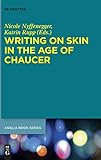Writing on Skin in the Age of Chaucer / ed. by Nicole Nyffenegger, Katrin Rupp.
Material type: TextSeries: Buchreihe der Anglia / Anglia Book Series ; 60Publisher: Berlin ; Boston : De Gruyter, [2018]Copyright date: ©2018Description: 1 online resource (VII, 273 p.)Content type:
TextSeries: Buchreihe der Anglia / Anglia Book Series ; 60Publisher: Berlin ; Boston : De Gruyter, [2018]Copyright date: ©2018Description: 1 online resource (VII, 273 p.)Content type: - 9783110575729
- 9783110575873
- 9783110578133
- online - DeGruyter
- Issued also in print.
| Item type | Current library | Call number | URL | Status | Notes | Barcode | |
|---|---|---|---|---|---|---|---|
 eBook
eBook
|
Biblioteca "Angelicum" Pont. Univ. S.Tommaso d'Aquino Nuvola online | online - DeGruyter (Browse shelf(Opens below)) | Online access | Not for loan (Accesso limitato) | Accesso per gli utenti autorizzati / Access for authorized users | (dgr)9783110578133 |
Frontmatter -- Table of Contents -- Acknowledgements -- Introduction: Writing on Skin in the Age of Chaucer -- Part I: Reading Diseased Skin -- Doctrinal Dermatologies -- The “Scabbe of Synne:” Reading Leprous Skin in Late Medieval Culture -- Legible Leprosy: Skin Disease in the Testament of Cresseid, Chaucer’s Summoner, and Amis and Amiloun -- Part II: Textual Skins -- Chaucer’s Ethical Palimpsest: Dermal Reflexivity in the General Prologue -- The Cook’s “Mormal:” Reading Disease, Doubt, and Deviance on the Body of Chaucer’s Cook -- Blushing, Paling, Turning Green: Hue and Its Metapoetic Function in Troilus and Criseyde -- Part III: Writing Dermal Identities -- Like a Second Skin: Appropriation and (Mis)interpretation of Identities in Sir Gawain and the Green Knight and William of Palerne -- Queer Skin in the “Wife of Bath’s Prologue” and Its Manuscript Glosses -- Reconstructing the Pardoner: Transgender Skin Operations in Fragment VI -- Afterword: Skin Matters -- Contributors -- Index
restricted access online access with authorization star
http://purl.org/coar/access_right/c_16ec
Owing to its relatedness to parchment as the primary writing matter of the Middle Ages, human skin was not only a topic to write about in medieval texts, it was also conceived of as an inscribable surface, both in the material and in the figurative sense. This volume explores the textuality of human skin as discussed by Geoffrey Chaucer and other writers (medical, religious, philosophical, and literary) of the fourteenth and fifteenth century. It presents four main aspects of the complex relations between text, parchment, and human skin as they have been discussed in recent scholarship. These four aspects are, first, the (mostly figurative) resonances between parchment-making and transformations of human skin, second, parchment as a space of contact between animal and human spheres, third, human skin and parchment as sites where (gender) identities are negotiated, and fourth, the place of medieval skin studies within cultural studies and its relationship to the major concerns of cultural studies: the difficult demarcation of skin from body, the instability of any inscription, and the skin’s precarious state as an entity of its own.
Issued also in print.
Mode of access: Internet via World Wide Web.
In English.
Description based on online resource; title from PDF title page (publisher's Web site, viewed 25. Jun 2024)


